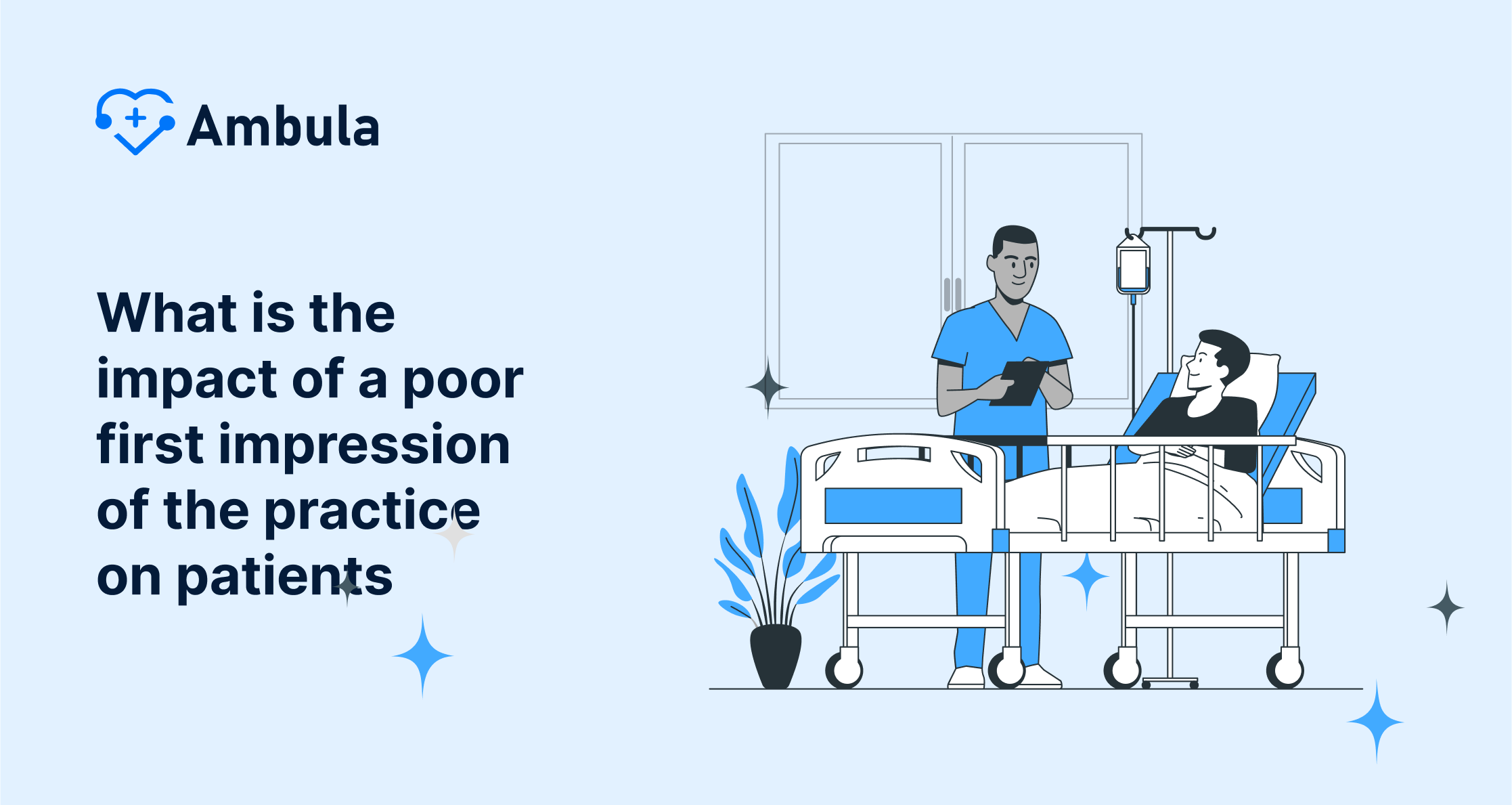Importance of first impressions in healthcare
We all have experienced the power of a first impression. There’s a reason why phrases like ‘making a good first impression’ are so prevalent in our everyday lexicon. The restaurant industry is built around this idea. The waiter who smiles genuinely, makes eye contact, introduces himself properly, and greets you warmly can make your dining experience memorable. Likewise, the positive experience provided by a friendly flight attendant can make even a long, exhausting flight enjoyable. These impressions, grounded in genuine warmth and consideration, set the stage for your interaction, whether ordering a meal or a flight or sharing your health concerns with healthcare providers.
Research has shown that this principle holds in healthcare settings as well. First impressions in healthcare can profoundly impact patient engagement, satisfaction scores, and overall patient experience. Physicians and nurses, like waiters and flight attendants, can dramatically improve patient interactions by offering a warm experience through their initial demeanor, facial expressions, and communication style.
- A study published in “Patient Education and Counseling” found that patients with a positive first impression of their doctor were more likely to be satisfied with their care overall.
- Another study published in “Health Communication” found that patients who felt their doctor was friendly and approachable were likelier to follow their treatment plan.
- A third study, published in the journal “BMC Health Services Research,” found that patients who felt that their doctor listened to them and took their concerns seriously were more likely to trust their doctor and have a positive overall experience.
What is the impact of a poor first impression of the practice on patients
In healthcare, a positive first impression is paramount. It shapes a patient’s perception of the entire experience, impacting their trust, comfort, and potential long-term relationship with the practice. A poor first impression can have detrimental consequences:
- Eroding Trust: Patients may hesitate to share concerns or follow treatment plans if they encounter long waits, rude staff, or an unwelcoming environment.
- Negative Word-of-mouth: Dissatisfied patients spread negative reviews, impacting the practice’s reputation and deterring potential patients.
- Reduced Compliance: Patients who feel uncomfortable or disrespected are less likely to adhere to treatment plans, leading to poorer health outcomes and increased costs.
- Elevated Anxiety: Stressful healthcare settings can be exacerbated by negative experiences, hindering communication and participation in decision-making.
- Financial Impact: A poor reputation can lead to a reduced patient base and revenue, impacting the practice’s ability to provide high-quality care.
Applying First Impressions in Healthcare
If an indifferent facial expression can ruin the dining experience at a restaurant, one can only imagine how detrimental it may be in a healthcare setting. Patients look to their healthcare providers – physicians, nurses, and other staff- to provide the best possible medical care, emotional reassurance, and compassion.
The PatientSET communication program, an initiative to improve communication between healthcare providers and patients, emphasizes the importance of initial interactions. The patient’s first impression can be positively influenced by a few simple actions: a warm and welcoming smile; an introduction that includes the provider’s name, role, and an overview of the visit’s plan; maintaining eye contact, acknowledging the patient’s wait, apologizing if needed, and an appropriate touch, like a hand on the shoulder, to communicate empathy and understanding. All these actions help patients feel more at ease and encourage them to openly share their concerns and questions.
The Positive Impact on Patient Satisfaction
Implementing these strategies leads to a rise in patient satisfaction scores. A positive patient experience begins the moment they walk into the healthcare facility. When healthcare providers greet patients with a smile, engage in open-ended questions about their well-being, and show genuine concern, it creates a sense of trust and confidence. Quality management in healthcare greatly depends on such aspects of the patient-care provider relationship.
Researchers point out that surprisingly, even non-medical gestures, like offering a glass of water or a blanket, improve the overall healthcare experience. This small gesture can provide a sense of comfort and security, which aids in the healing process.
The Role of Time Management in First Impressions
Time management also plays a pivotal role in shaping a strong first impression. More often than not, patients appreciate healthcare providers respecting their time. Overestimating the time needed for examinations or procedures and delivering services faster can increase patient satisfaction. It’s also important to maintain a communication line even in a busy workplace environment. Routine updates about the progress or possible delays comfort patients by making them feel involved in the process. Small gestures that improve patient comfort, like water or blankets, can also contribute to the positive experience. The key effective strategies for enhancing first impressions revolve around delivering empathetic, timely, and communicative healthcare.
Effective Strategies for Improving First Impressions
Cultivating positive first impressions in healthcare involves various effective strategies to build patient rapport and trust. First and foremost, maintaining a warm demeanor and showcasing emotional intelligence are vital. This includes a friendly greeting, maintaining eye contact, offering a genuine smile, and introducing oneself appropriately to set a welcoming tone. Active listening and an empathetic response are key to making patients feel heard and understood. Open-ended questions can encourage patients to share more about their health conditions, fears, or concerns. Apologizing for any inconvenience, like long waiting times, and acknowledging their discomfort or anxiousness can indicate respect and understanding from their point of view. Non-verbal cues, such as appropriate body language and touch, can further this bonding.
Understanding Patient Feedback
Patient feedback, usually gathered through surveys, is essential in assessing healthcare services from the patient’s perspective. These surveys provide valuable insights into a patient’s perception of their healthcare experience, the quality of communication from physicians and nurses, the effectiveness of treatments, and even seemingly peripheral aspects such as wait times, administrative assistance, and the hospital’s cleanliness. By understanding patient feedback, healthcare providers can identify strengths to reinforce and areas where improvement is needed to provide better patient care.
This feedback allows healthcare providers to implement necessary changes that substantively improve their care. Feedback gives voice to the patients, increases their engagement, and makes them active participants in their health journey. It can bring to light issues that healthcare providers were unaware of or compel them to rethink an aspect of their practice. Thus, understanding patient feedback is beneficial and crucial for enhancing the patient experience and overall satisfaction.
Final Thoughts
In conclusion, the importance of first impressions cannot be overstated in healthcare settings. Though we all have different personalities and varying abilities to express empathy, adopting some basic communication methods, such as a warm smile, eye contact, a pause to address the patient’s concern, can go a long way in creating a better healthcare environment. By focusing on these areas for improvement, we can create a healthcare experience that cures and cares.







